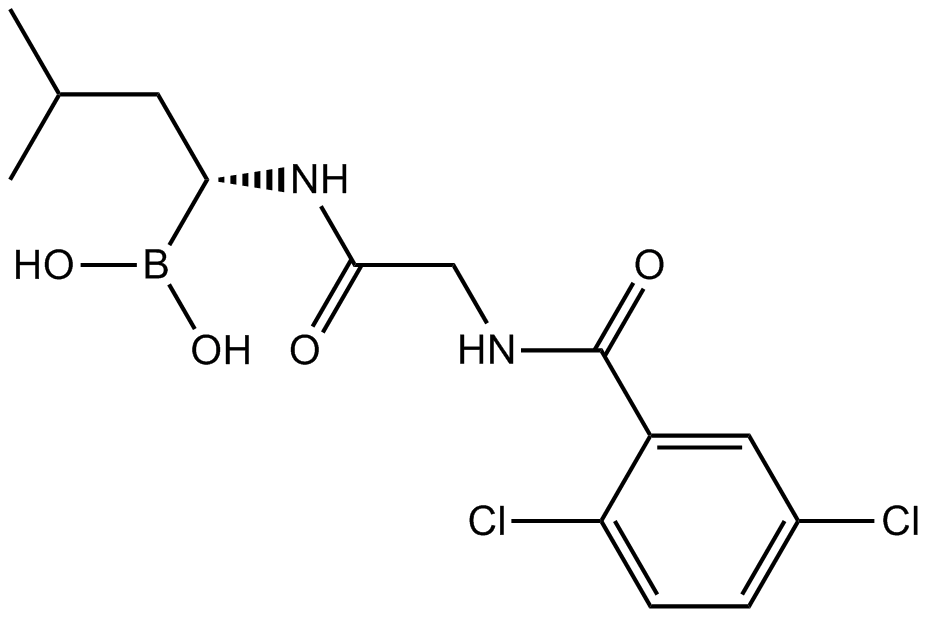MLN2238 |
| Catalog No.GC16146 |
A 20S proteasome inhibitor and an active metabolite of MLN9708
Products are for research use only. Not for human use. We do not sell to patients.

Cas No.: 1072833-77-2
Sample solution is provided at 25 µL, 10mM.
MLN2238 is a potent reversible inhibitor that inhibits specific β5 site of the 20S proteasome with IC50 value of 3.4 nM and Ki value of 0.93 nM.[1]
MLN2238, an N-capped dipeptidyl leucine boronic acid , preferentially bound to and inhibited the chymotrypsin-like proteolytic (β5) site of the 20S proteasome with an IC50 value of 3.4 nM (Ki value of 0.93 nM). As the concentration increased, it also inhibited the caspase-like (β1) with IC50 value of 31 nM and trypsin-like (β2) proteolytic sites with IC50 value of 3,500 nM. The clinical studies in the model of both solid-tumor and hematological xenograft have demonstrated preclinical antitumor activity. Comparing to bortezomib, MLN2238 showed the activity in pharmacokinetics, pharmacodynamics and antitumor. It is believed that the activation of caspases, the p53 pathway, and endoplasmic reticulum stress and inhibition of NF-κB are related to MLN2238-induced MM cell death. [1,2]
MLN2238 inhibited growth and triggers apoptosis in MM cells resistant to conventional and bortezomib therapies without affecting the viability of normal cells [2]. MLN2238 has significant cytotoxic activity in RSCL and RRCL preclinical models. Although BTZ and MLN2238 have similar reversible proteasome inhibition, the proteasome dissociation half-life (t1/2) of MLN2238 was found to be approximately sixfold faster than BTZ (t1/2 of 18 vs. 110min, respectively) while has the similar LD50 values to BTZ in a variety of cultured mammalian cancer cell lines. MLN2238 is approximately two to three times more potent than BTZ in lymphoma cell models. The IC50 of MLN2238 was 2.5 nmol/l in contrast to 7.5nmol/l of BTZ in Raji parental cells. [3]
In many mouse models of hematologic malignancies, such as tumor xenograft models which derived from a human lymphoma cell line and primary human lymphoma tissue, and genetically engineered mouse models of plasma cell malignancies, the result showed the antitumor activity of MLN2238.[4]
References:
1.Kupperman E, Lee EC, Cao Y, et al. Evaluation of the proteasome inhibitor MLN9708 in preclinical models of human cancer. Cancer Research, 2010, 70 (5): 1970-80.
2.Tian Z, Zhao J, Tai Y, et al. Investigational agent MLN9708/2238 targets tumor-suppressor miR33b in MM cells. Blood, 2012, 120 (19): 3958-3967
3.Gu JJ, Hernandez-Ilizaliturri FJ, Mavis C, et al. MLN2238, a proteasome inhibitor, induces caspase-dependent cell death, cell cycle arrest, and potentiates the cytotoxic activity of chemotherapy agents in rituximab-chemotherapy-sensitive or rituximab-chemotherapy-resistant B-cell lymphoma preclinical models. ANTI-CANCER DRUGS, 2013, 24 (10): 1030-1038.
4.Lee EC, Fitzgerald M, Bannerman B, et al. Antitumor Activity of the Investigational Proteasome Inhibitor MLN9708 in Mouse Models of B-cell and Plasma Cell Malignancies. CLINICAL CANCER RESEARCH, 2011, 17 (23): 7313-7323.
Average Rating: 5 (Based on Reviews and 30 reference(s) in Google Scholar.)
GLPBIO products are for RESEARCH USE ONLY. Please make sure your review or question is research based.
Required fields are marked with *




















